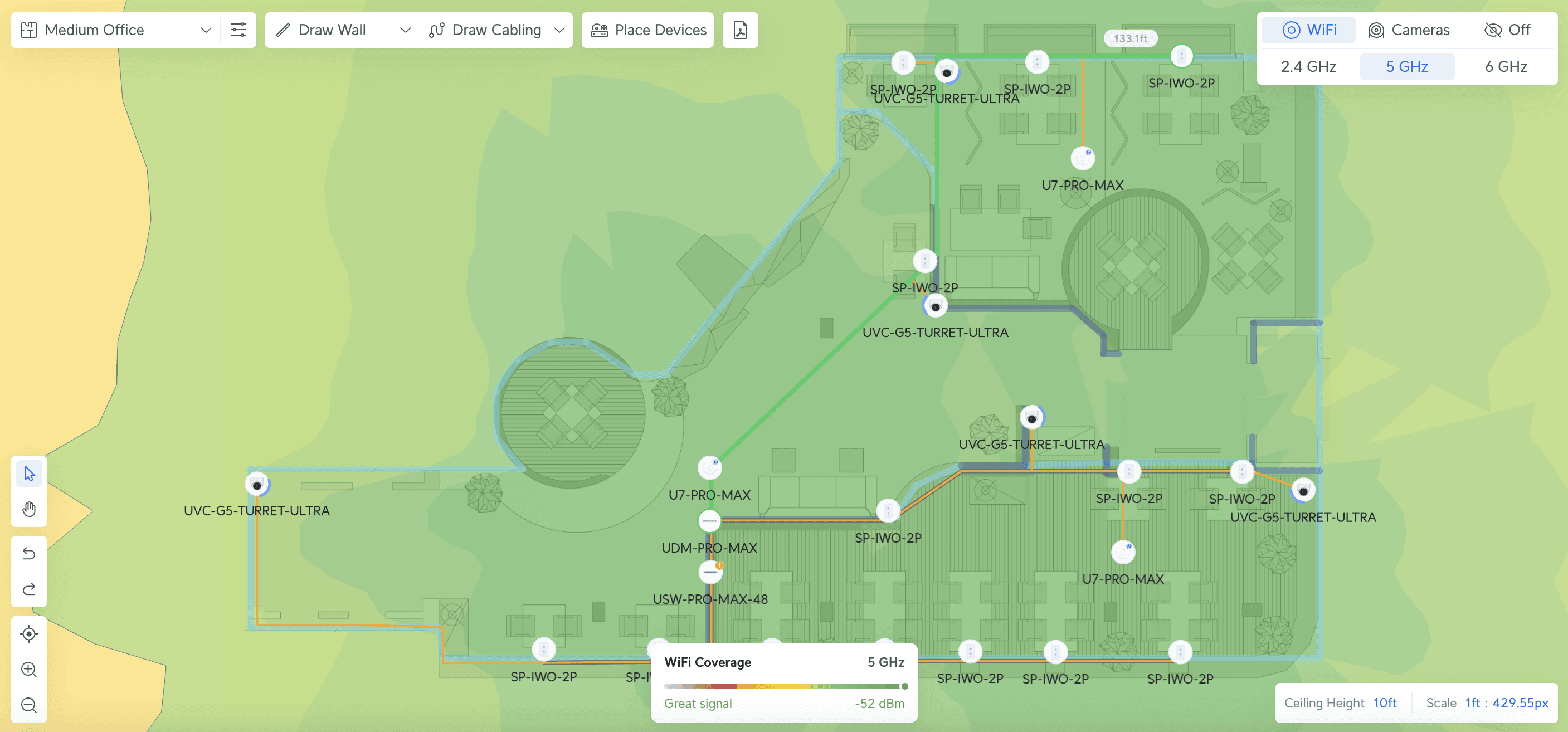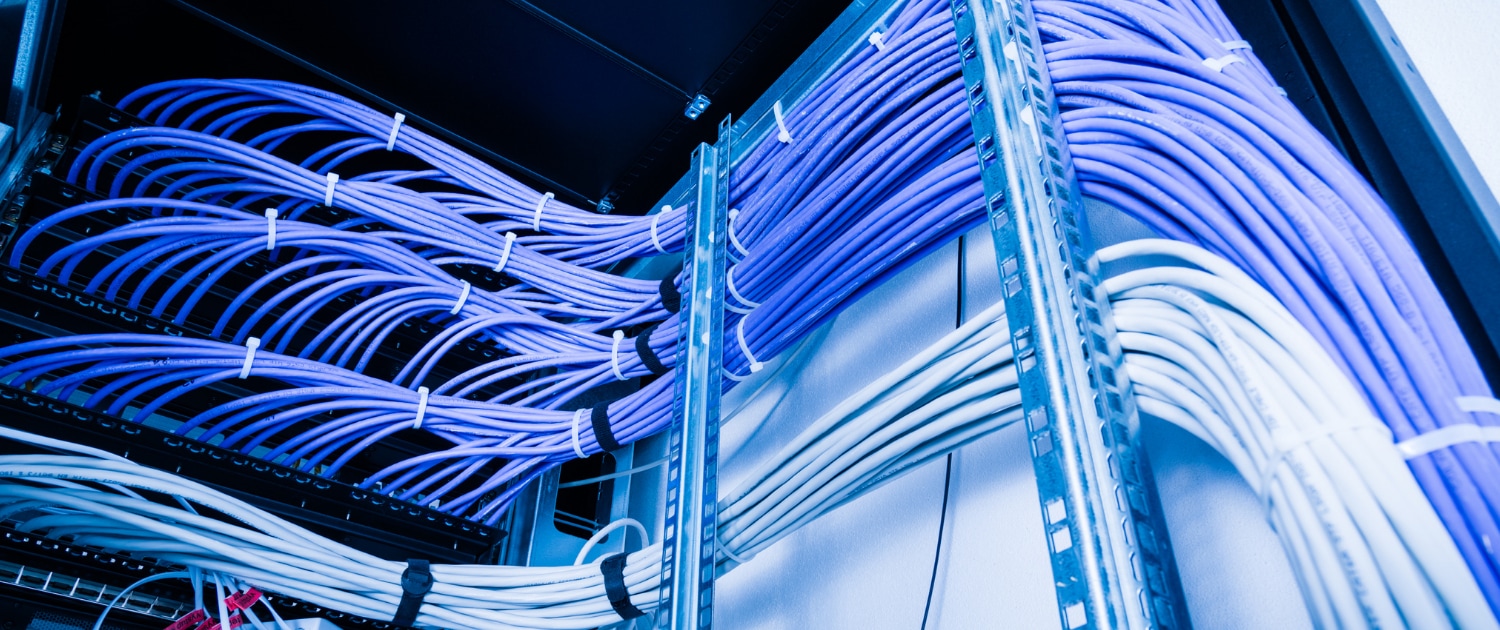Published: September 14, 2025 | Last updated: September 14, 2025
Key Takeaway: Professional network design involves systematic planning of coverage, capacity, and infrastructure to ensure reliable connectivity that scales with business growth. This guide demonstrates proven methodology using a recent Miami office installation featuring WiFi 7 technology and enterprise-grade infrastructure.
Modern businesses depend on reliable network infrastructure for daily operations, yet many organizations experience inadequate WiFi coverage, slow internet speeds, and network bottlenecks that impact productivity. Professional network design addresses these challenges through systematic planning, appropriate equipment selection, and strategic implementation.
This guide examines network design methodology through a real-world case study: a comprehensive office network installation in Miami's Brickell district. The project demonstrates how proper planning, modern equipment, and professional installation create a foundation for business growth and operational efficiency.
Understanding Professional Network Design
Professional network design extends beyond installing WiFi access points throughout an office. The process involves analyzing business requirements, planning coverage patterns, selecting appropriate equipment, and designing infrastructure that supports both current needs and future growth.
Core Design Principles
- Coverage Analysis: Ensuring reliable connectivity throughout the workspace
- Capacity Planning: Supporting current and projected user loads
- Infrastructure Design: Creating a scalable wired backbone infrastructure
- Equipment Selection: Choosing enterprise-grade components for reliability
- Future-Proofing: Planning for technological advancement and business growth
The network design process begins with understanding how employees use technology in their workspace. Modern offices require support for laptops, smartphones, tablets, smart displays, and emerging IoT devices. Each device type has different bandwidth requirements, latency sensitivities, and connection patterns that influence network design decisions.
Business-grade networking equipment differs from consumer products in terms of management capabilities, performance consistency, and reliability. Professional installations use managed switches, enterprise access points, and centralized management systems that provide visibility and control over network performance. For comprehensive guidance on business networking fundamentals, our UniFi business network guide covers essential concepts and implementation strategies.
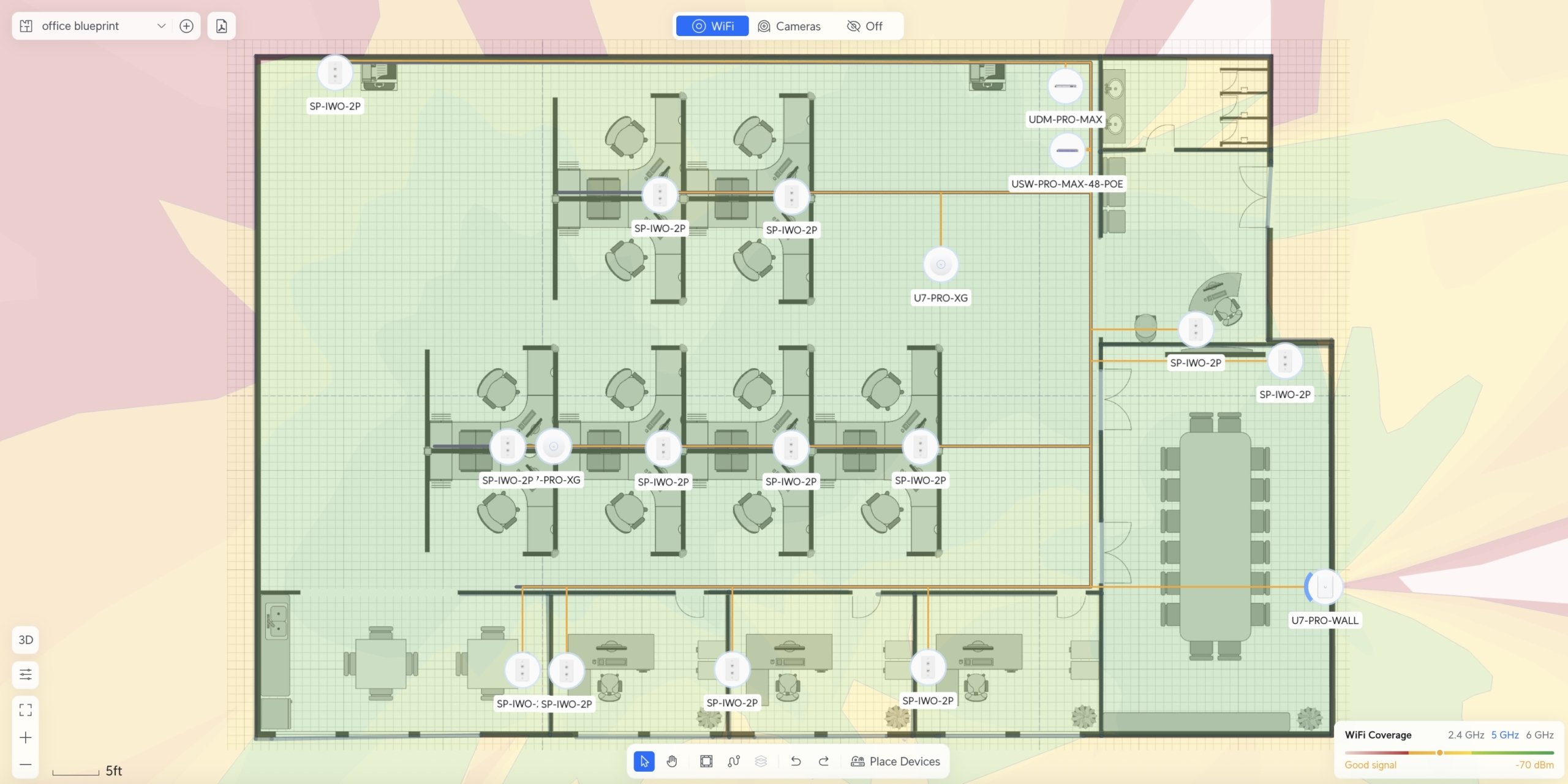
Screenshot
Case Study: Miami Office Network Design
Our recent Brickell office installation demonstrates network design methodology in action. The project required supporting a modern workspace with multiple individual offices, conference rooms, and collaborative areas within a 2,500 square foot space.
Project Requirements Analysis
The initial assessment identified specific business requirements that shaped the network design approach. The office needed to support up to 40 concurrent users across various device types, with particular emphasis on video conferencing capabilities and cloud-based application performance.
Business Requirements Identified
- Support for 40+ concurrent wireless devices
- High-performance video conferencing in multiple rooms
- Reliable connectivity for cloud-based productivity applications
- Guest network access with appropriate security isolation
- Structured cabling to support wired workstations
- Scalability for potential office expansion
The assessment process involved analyzing the existing space layout, identifying potential interference sources, evaluating electrical infrastructure, and understanding workflow patterns. This information guides equipment selection and placement decisions that ensure optimal performance.
Equipment Selection Methodology
Equipment selection balanced performance requirements, budget considerations, and long-term value. The project utilized UniFi's latest WiFi 7 technology to provide advanced wireless performance while maintaining compatibility with existing device ecosystems.
Primary Network Components:
The network foundation centers around the UniFi Dream Machine Pro Max, which serves as the network gateway, firewall, and management controller. This device provides enterprise-grade security features, traffic management capabilities, and centralized monitoring for the entire network infrastructure.
The switching infrastructure uses a UniFi Pro Max 48 PoE switch, providing 48 Gigabit Ethernet ports with Power over Ethernet capability. This configuration supports both wired workstation connections and powers wireless access points through a single cable connection, simplifying installation and reducing infrastructure complexity.
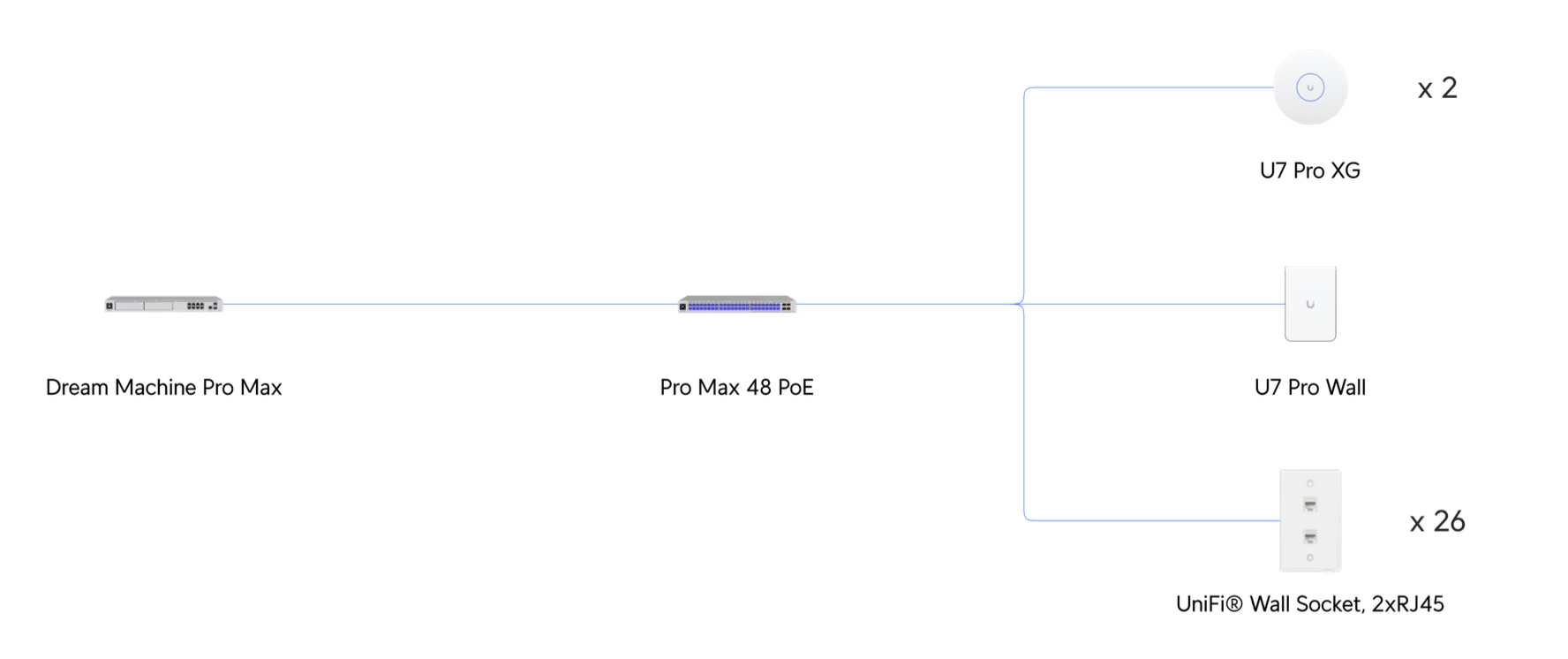
WiFi 7 Access Point Deployment:
Wireless coverage utilizes the latest UniFi Access Point U7 Pro XG models, which provide WiFi 7 performance with support for the 6 GHz band. These access points deliver improved performance compared to previous WiFi generations, particularly in high-density environments with many concurrent users.
The installation includes two ceiling-mounted U7 Pro XG units for general office coverage and one UniFi Access Point U7 Pro Wall for targeted coverage in conference areas. This combination ensures comprehensive wireless coverage while optimizing signal strength and capacity distribution.
Coverage Planning and Analysis
Professional network design requires detailed coverage analysis to ensure reliable connectivity throughout the workspace. The planning process uses site surveys, RF modeling, and coverage prediction tools to optimize access point placement.
Multi-Band Coverage Strategy:
WiFi 7 access points operate across three frequency bands: 2.4 GHz, 5 GHz, and 6 GHz. Each band serves different purposes in the overall connectivity strategy:
- 2.4 GHz Band: Provides extended range coverage for IoT devices and older equipment
- 5 GHz Band: Delivers high-performance connectivity for laptops and productivity devices
- 6 GHz Band: Offers cleaner spectrum for bandwidth-intensive applications
The coverage analysis demonstrates strong signal strength throughout the office space across all frequency bands. The design eliminates dead zones while preventing excessive signal overlap that can cause interference and performance degradation.
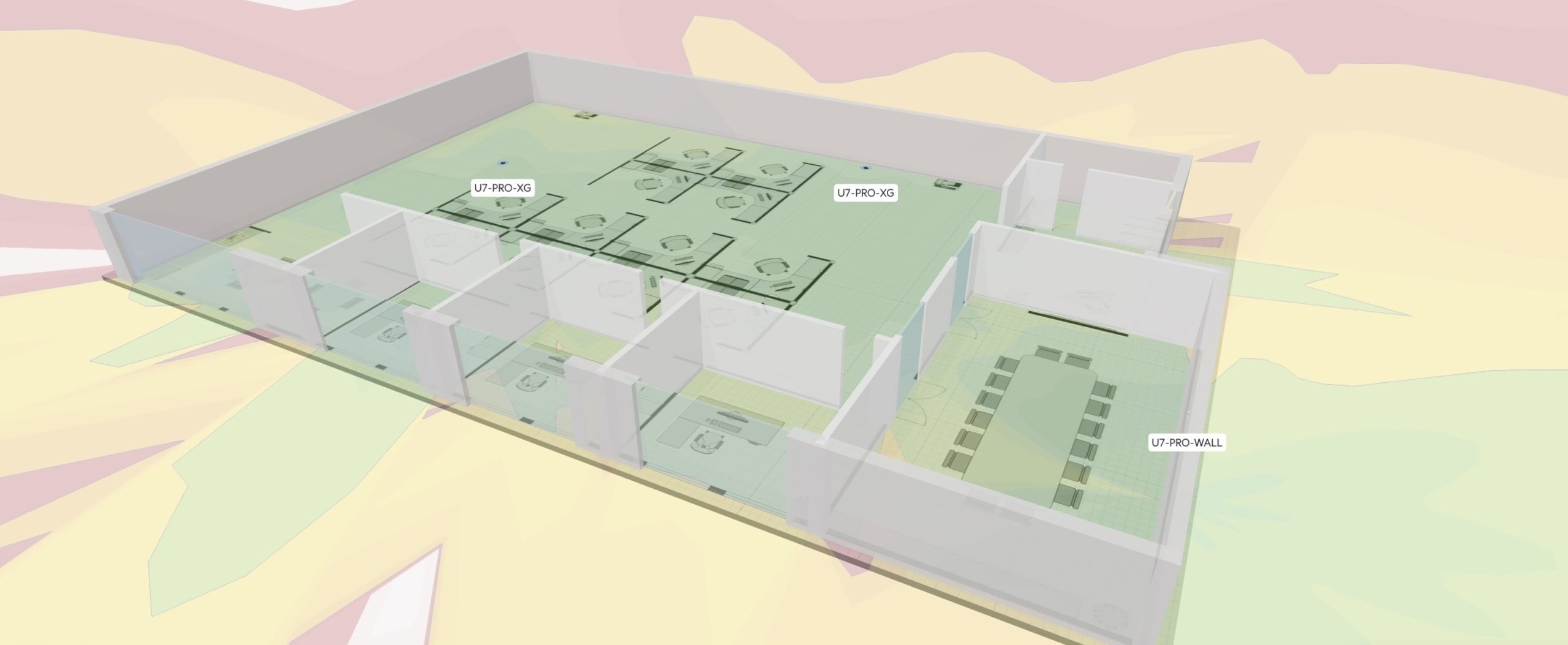
Access Point Placement Strategy:
Strategic access point placement considers both RF coverage and practical installation requirements. The ceiling-mounted units provide broad coverage patterns suitable for open office areas, while the wall-mounted unit delivers targeted performance for conference room applications.
Access point positioning accounts for potential interference sources, including other wireless networks, microwave ovens, and Bluetooth devices. The design maintains appropriate spacing between access points to optimize performance while providing redundancy for critical areas.
Structured Cabling Infrastructure
Professional network installations include comprehensive structured cabling to support both current wired connections and future expansion requirements. The cabling infrastructure provides the foundation for reliable network performance and simplified device management.
Cable Selection and Installation
The installation utilizes UniFi Indoor Cable CMP throughout the infrastructure. CMP-rated cable meets plenum requirements for installation in air handling spaces, ensuring code compliance and safety in commercial environments.
Structured cabling design incorporates 13 wall-mounted network outlets using dual RJ45 connections at each workstation location. This configuration supports both computer connections and IP phone deployments while maintaining flexibility for future device additions.
Cabling Infrastructure Benefits
- Reliable wired connections for stationary workstations
- Power over Ethernet support for IP phones and access points
- Reduced wireless congestion through strategic wired connections
- Future-ready infrastructure supporting emerging technologies
- Professional appearance with concealed cable management
Installation Planning and Execution
Network installation requires careful coordination with other construction activities and adherence to commercial building codes. The installation involves cable pathway planning, mounting equipment, and systematic testing to ensure reliable operation.
Professional installation includes proper cable management, appropriate grounding, and documentation of all connections. This attention to detail ensures long-term reliability and simplifies future maintenance or expansion activities.
WiFi 7 Technology Advantages
Implementing WiFi 7 technology provides advantages for business networking applications. WiFi 7 introduces several technical improvements that enhance performance, reliability, and capacity compared to previous wireless standards.
Performance Improvements
WiFi 7 delivers theoretical maximum speeds exceeding 30 Gbps through wider channel widths, higher modulation schemes, and improved spatial streaming capabilities. While real-world speeds remain lower than theoretical maximums, businesses typically experience 2-3x performance improvements compared to WiFi 6 installations.
Multi-Link Operation (MLO) is a key WiFi 7 advancement. It allows devices to connect across multiple frequency bands simultaneously, reducing latency and improving reliability by providing multiple data paths between devices and access points.
WiFi 7 Technical Features
- 320 MHz Channels: Doubled channel width compared to WiFi 6
- 4096-QAM Modulation: Improved data encoding efficiency
- Multi-Link Operation: Simultaneous multi-band connections
- Enhanced MU-MIMO: Better support for multiple concurrent users
- 6 GHz Band Access: Less congested spectrum with minimal interference
Future-Proofing Considerations
WiFi 7 adoption ensures network infrastructure remains current as client devices upgrade to support the latest wireless standards. While many current devices connect using older WiFi standards, the infrastructure supports seamless transitions as organizations refresh laptops, tablets, and smartphones.
The 6 GHz band provides particular long-term value due to its cleaner spectrum and reduced interference compared to traditional 2.4 GHz and 5 GHz frequencies. This spectrum remains relatively uncongested, ensuring consistent performance even as wireless device density continues increasing.
Network Management and Monitoring
Network installations include comprehensive management and monitoring capabilities that provide visibility into network performance, usage patterns, and potential issues. The UniFi ecosystem offers centralized management through the Network Management application.
Centralized Management Benefits
The Dream Machine Pro Max serves as the network controller, providing a single management interface for all network components. This centralized approach simplifies configuration management, firmware updates, and performance monitoring across the entire infrastructure.
Network administrators can monitor real-time usage, identify bandwidth-intensive applications, and optimize performance through traffic shaping and quality of service controls. These capabilities ensure consistent performance for business-critical applications while managing recreational usage.
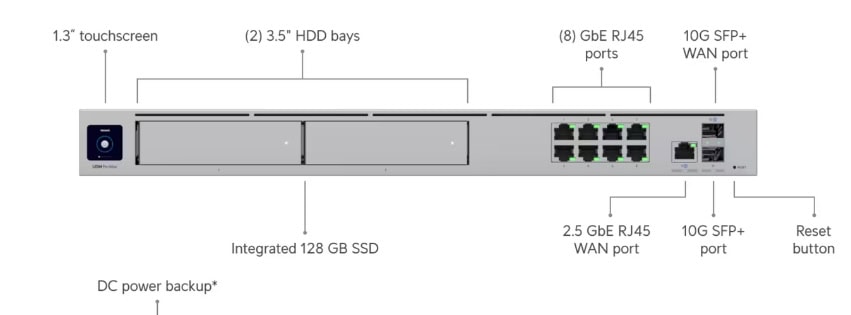
Network Management Features
- Real-time device monitoring and usage analytics
- Automated firmware updates and security patches
- Guest network management and access controls
- Traffic analysis and bandwidth optimization
- Security threat detection and response
- Remote monitoring and troubleshooting capabilities
Performance Optimization
Ongoing network optimization involves analyzing usage patterns, identifying bottlenecks, and adjusting configurations to maintain optimal performance. The management system provides detailed analytics that guide optimization decisions and capacity planning.
Regular performance monitoring helps identify issues before they impact business operations. Proactive management includes monitoring for interference sources, analyzing client connection patterns, and optimizing access point configurations based on actual usage data.
Security Implementation
Professional network design incorporates multiple security layers to protect business data and ensure compliance with industry requirements. The security implementation includes network segmentation, access controls, and threat detection capabilities.
Network security represents a critical component of modern business infrastructure. Our comprehensive cybersecurity software guide provides a detailed analysis of security solutions that complement network infrastructure protection.
Network Segmentation Strategy
The network design implements logical segmentation to isolate different types of traffic and limit potential security exposure. Employee devices connect to the primary corporate network, while guest devices receive internet access through an isolated network segment.
IoT devices such as smart displays, printers, and environmental sensors connect to a separate network segment that prevents lateral movement while maintaining necessary functionality. This segmentation approach reduces attack surface area and contains potential security incidents.
Multi-Layer Security Approach
- Firewall Protection: Advanced threat detection and prevention
- Network Segmentation: Isolated VLANs for different device types
- Access Control: WPA3 encryption and certificate-based authentication
- Intrusion Detection: Automated monitoring for suspicious activity
- Content Filtering: DNS-based protection against malicious websites
Authentication and Access Control
Modern business networks require robust authentication systems to verify user identity and control network access. Password security forms the foundation of network access control. Our business password manager comparison helps organizations implement strong authentication practices that integrate with network security policies.
The network supports multiple authentication methods, including WPA3-Personal for small teams and WPA3-Enterprise with RADIUS authentication for larger organizations requiring individual user credentials and centralized management.
Compliance Considerations
Business networks often require compliance with industry-specific security standards. The network design supports common compliance requirements through logging, access controls, and audit trail capabilities that demonstrate adherence to security policies.
Regular security assessments and penetration testing validate the effectiveness of implemented security controls. Network management includes ongoing security monitoring and rapid response to emerging threats or vulnerabilities.
Scalability and Future Growth
Network design anticipates business growth and technology evolution through infrastructure choices that support expansion without requiring complete replacement. The installed infrastructure provides substantial headroom for additional users and emerging technology requirements.
Capacity Planning
The current installation supports up to 80-100 concurrent wireless devices while maintaining performance for business applications. This capacity provides headroom above current requirements, accommodating natural growth and temporary peak usage scenarios.
The structured cabling infrastructure includes spare capacity for additional wired connections, access point expansion, and integration of new technologies such as IoT sensors or smart building systems. This forward-thinking approach minimizes future disruption and installation costs.
Scalability Features
- PoE switch capacity for additional access points
- Spare cable runs for future wired connections
- Modular switch architecture supporting expansion
- Cloud management enabling remote site support
- API integration for business application connectivity
Technology Evolution Support
The WiFi 7 infrastructure supports current device requirements while providing compatibility for future wireless standards and emerging technologies. The 6 GHz band support ensures long-term relevance as client devices adopt the latest wireless capabilities.
Network management APIs enable integration with business applications, building automation systems, and emerging IoT platforms. This integration capability positions the network as a business enablement tool rather than simply a connectivity infrastructure.
Professional Installation Process
Network installation involves systematic planning, careful execution, and comprehensive testing to ensure reliable operation. The installation process coordinates multiple trades and follows established project management methodologies to minimize business disruption.
Project Planning and Coordination
Installation projects begin with detailed planning that addresses timeline requirements, coordination with other trades, and minimizes disruption to business operations. Pre-installation site surveys verify design assumptions and identify potential challenges before equipment arrives.
Material coordination ensures all components arrive when needed while maintaining secure storage for valuable networking equipment. Professional installations include contingency planning for unexpected issues and clear communication throughout the project timeline.
Installation Process Phases
- Pre-Installation: Site survey verification and material coordination
- Cabling Installation: Structured cabling and pathway installation
- Equipment Mounting: Access point and switch installation
- System Configuration: Network setup and security implementation
- Testing and Optimization: Performance validation and tuning
- Documentation and Training: System handover and user education
Quality Assurance and Testing
The installations include comprehensive testing protocols that verify performance, security, and reliability before system handover. Testing includes cable certification, wireless coverage validation, and security configuration verification.
Performance testing validates throughput, latency, and connectivity across all coverage areas using multiple device types. This comprehensive approach ensures the installed system meets design specifications and business requirements.
Investment Analysis and Business Value
Proficient network infrastructure represents a business investment that generates returns through improved productivity, reduced downtime, and enhanced capabilities. Understanding the financial impact helps justify the investment and guide design decisions.
Productivity Improvements
Reliable network connectivity eliminates productivity losses from connection drops, slow performance, and WiFi dead zones. Research indicates that network issues cost knowledge workers approximately 45-60 minutes per week in lost productivity, representing substantial costs for organizations with multiple employees.
Modern wireless infrastructure enables mobile work patterns, improves collaboration capabilities, and supports new business applications that enhance operational efficiency. These productivity gains often justify the initial infrastructure investment within 12-18 months.
Business Value Factors
- Eliminated productivity losses from network issues
- Reduced IT support costs through reliable infrastructure
- Enhanced collaboration and communication capabilities
- Support for new business applications and processes
- Improved customer experience through reliable connectivity
- Future-proofing and reducing premature replacement costs
Operational Cost Considerations
A proper network infrastructure reduces ongoing operational costs through improved reliability, centralized management, and reduced support requirements. Enterprise-grade equipment typically provides 5-7 years of reliable service compared to 2-3 years for consumer products.
Centralized management reduces the time required for network administration, firmware updates, and troubleshooting. These operational efficiencies generate ongoing cost savings that contribute to positive return on investment over the system lifecycle.
Common Design Challenges and Solutions
It requires attention to numerous technical and practical considerations. Understanding common challenges helps ensure installations that meet business requirements and provide long-term value.
Coverage and Capacity Planning
Many network installations struggle with inadequate coverage analysis, resulting in dead zones, poor performance, or over-engineered solutions that waste resources. Professional design includes comprehensive site surveys and RF modeling to optimize access point placement.
Interference analysis identifies potential sources of wireless interference and plans appropriate mitigation strategies. This proactive approach prevents performance issues that are difficult and expensive to resolve after installation completion.
Design Considerations
- Comprehensive coverage analysis to prevent dead zones
- Appropriate access point density to avoid interference
- Adequate power planning for PoE requirements
- Professional cable management for reliability
- Capacity planning that accommodates growth
- Security configuration aligned with business requirements
Equipment Selection and Integration
Choosing appropriate equipment requires balancing performance requirements, budget constraints, and long-term value. Experienced designers optimize investment outcomes through careful analysis of business needs and technology capabilities.
Enterprise-grade components provide better total cost of ownership despite higher initial costs through improved reliability, management capabilities, and support options. Consumer-grade equipment may offer attractive pricing but lacks the features required for business applications.
Maintenance and Support Planning
It includes ongoing maintenance and support planning to ensure continued reliability and performance. Proper maintenance extends equipment lifecycle and prevents minor issues from becoming major problems.
Preventive Maintenance Programs
Regular maintenance includes firmware updates, performance monitoring, and capacity analysis to optimize network performance. Automated update capabilities in UniFi equipment simplify maintenance while ensuring security patches receive prompt deployment.
Periodic site assessments verify that network performance continues meeting business requirements as usage patterns evolve. These assessments identify optimization opportunities and plan for future expansion or technology refresh requirements.
Ongoing Support Requirements
- Regular firmware updates and security patches
- Performance monitoring and optimization
- Capacity analysis and expansion planning
- Hardware health monitoring and replacement planning
- Security assessment and configuration updates
- User training and support documentation
Support and Warranty Considerations
Professional installations include comprehensive warranty coverage and support options that provide confidence for business-critical infrastructure. UniFi equipment includes manufacturer warranties and access to technical support resources.
Local installation partners provide ongoing support, troubleshooting, and expansion services that ensure businesses can focus on their core operations rather than network management. This professional support represents valuable protection for mission-critical infrastructure.
For organizations requiring additional backup and security measures, our business backup solutions guide provides a comprehensive analysis of data protection strategies that complement network infrastructure investments.
Frequently Asked Questions
How long does professional network design and installation typically take?
Network installations typically require 2-4 weeks from initial assessment to final testing. Complex installations or those requiring coordination with construction activities may extend to 6-8 weeks. The timeline includes design development, equipment procurement, installation, configuration, and comprehensive testing.
What factors influence network equipment selection for business installations?
Equipment selection considers user capacity requirements, coverage area, building construction materials, interference sources, budget constraints, and future growth plans. We try to balance performance requirements with cost considerations to optimize long-term value while meeting current business needs.
How does WiFi 7 compare to previous wireless standards for business applications?
WiFi 7 provides improvements in speed, capacity, and reliability compared to WiFi 6. Key business benefits include support for more concurrent devices, reduced latency through Multi-Link Operation, and access to the 6 GHz spectrum. These improvements particularly benefit high-density environments and bandwidth-intensive applications.
What ongoing maintenance does professional network infrastructure require?
They require regular firmware updates, performance monitoring, and periodic optimization. Most maintenance tasks can be automated or performed remotely. Annual assessments help identify optimization opportunities and plan for future expansion or technology refresh requirements.
How do professional installations handle security and compliance requirements?
Proficient network design implements multiple security layers, including network segmentation, access controls, threat detection, and logging capabilities. The design supports common compliance requirements and includes ongoing security monitoring and rapid response to emerging threats or vulnerabilities.
What is the typical return on investment for professional network infrastructure?
Network infrastructure typically generates positive ROI within 12-24 months through improved productivity, reduced downtime, and operational efficiencies. The exact timeline depends on organization size, current infrastructure quality, and specific business applications supported by the network.
How does professional network design accommodate future technology changes?
It includes spare capacity, modular architecture, and standards-based components that support future expansion and technology upgrades. The infrastructure typically supports 5-7 years of technology evolution without requiring complete replacement, providing excellent long-term value.
Disclosure: iFeelTech participates in the Ubiquiti Creator Program.
We may earn a commission when you purchase UniFi products through our links at no
additional cost to you. Our recommendations are based on professional experience and testing.
